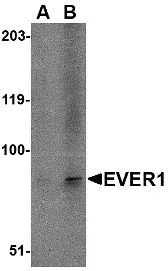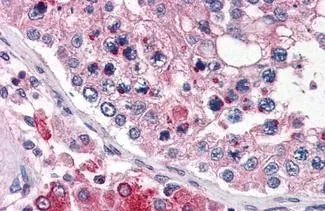
WB analysis of A-20 cell lysate using GTX85762 TMC6 antibody. Dilution : 1 microg/mL (Lane A) and 2 microg/mL (Lane B)
TMC6 antibody
GTX85762
ApplicationsWestern Blot, ELISA, ImmunoHistoChemistry, ImmunoHistoChemistry Paraffin
Product group Antibodies
ReactivityHuman, Mouse, Rat
TargetTMC6
Overview
- SupplierGeneTex
- Product NameTMC6 antibody
- Delivery Days Customer9
- Antibody SpecificityThis EVER1 antibody does not cross-react with EVER2.
- Application Supplier NoteWB: 1 - 2 microg/ml. IHC-P: 5 microg/ml. *Optimal dilutions/concentrations should be determined by the researcher.Not tested in other applications.
- ApplicationsWestern Blot, ELISA, ImmunoHistoChemistry, ImmunoHistoChemistry Paraffin
- CertificationResearch Use Only
- ClonalityPolyclonal
- Concentration1 mg/ml
- ConjugateUnconjugated
- Gene ID11322
- Target nameTMC6
- Target descriptiontransmembrane channel like 6
- Target synonymsepidermodysplasia verruciformis 1; epidermodysplasia verruciformis protein 1; EV1; EVER1; EVIN1; expressed in activated T/LAK lymphocytes; LAK-4P; lnc; protein LAK-4; TNRC6C antisense RNA 1; TNRC6C-AS1; transmembrane channel-like protein 6
- HostRabbit
- IsotypeIgG
- Protein IDQ7Z403
- Protein NameTransmembrane channel-like protein 6
- Scientific DescriptionEpidermodysplasia verruciformis (EV) is an autosomal recessive dermatosis characterized by abnormal susceptibility to human papillomaviruses (HPVs) and a high rate of progression to squamous cell carcinoma on sun-exposed skin. EV is caused by mutations in either of two adjacent genes located on chromosome 17q25.3. Both of these genes encode integral membrane proteins that localize to the endoplasmic reticulum and are predicted to form transmembrane channels. This gene encodes a transmembrane channel-like protein with 10 transmembrane domains and 2 leucine zipper motifs. [provided by RefSeq, Jul 2008]
- ReactivityHuman, Mouse, Rat
- Storage Instruction-20°C or -80°C,2°C to 8°C
- UNSPSC12352203

